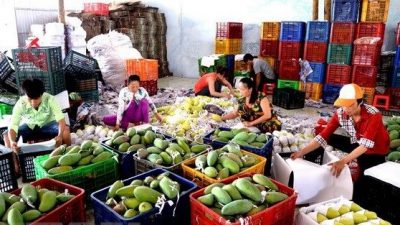
|
The volume of investment in Vietnam’s retail market is expected to rise to US$350 billion in 2025, thanks to consumers’ higher income levels, making Vietnam an attractive destination to foreign investors. |
|
But in recent years, the market has seen the departure of many world-famous retail brands, which were then replaced with the brands of new owners. Such a movement indicates fierce competition in the retail market but also offers hope for domestic enterprises if they can capitalise on opportunities and create breakthroughs to capture the market. Fierce competition Amid the Covid-19 pandemic in 2020, Vietnam’s retail market still recorded decent growth. According to the Ministry of Industry and Trade (MOIT), retail sale revenue was estimated at VND3.9 quadrillion (US$168 billion), accounting for 79% of total retail and consumer service revenue and up 6.8% compared with the previous year. Such figures demonstrate a retail market with huge potential and large room for development, but also fierce competition, requiring a market classification and the development of retail models that suit different types of consumers. The Vietnamese retail market has seen significant changes in market shares and brands through a series of transfers, mergers and acquisitions. Most recently, Thailand’s Central Retail officially scrapped the Big C brand and replaced it with Go! and Tops Market in a move to redefine their brands in Vietnam. Earlier, in late 2020, E-Mart of the Republic of Korea announced plans to retreat from the Vietnamese market as it was unable to open any new stores except for the only hypermarket in Ho Chi Minh City after five years of its presence in Vietnam. In fact, the retail market has seen significant changes in recent years. In 2016, many of the public were shocked to know that more than half of Vietnam’s retail market belonged to foreign companies and there were gloomy predictions for Vietnam’s retail sector. But after nearly five years, domestic retailers have recorded strong growth with an expanding network of stores and are prevailing over foreign competitors. Statistics by the MOIT’s Department of Domestic Market, Vietnam currently has about 1,085 supermarkets, 240 shopping centres and nearly 2,000 convenience stores, of which domestic enterprises account for 70-80% of total outlets. The increasing coverage shows that domestic retailers will not give in and are still quietly expanding their business and seeking to reverse the situation in order to dominate the home turf with their own strengths. Domestic retailers have demonstrated their cleverness by reinforcing their market shares in major cities while also targeting rural areas in order to meet consumers’ demand to buy goods quickly and conveniently. Following market signals closely A look at the ups and downs of well-known retail brands in Vietnam shows that the retail market is a big pie, but it is not easy to swallow. The departure of major names such as Auchan (France) and Parkson (Malaysia) is evidence that this is not an easy playing field. That is because, besides location, changes in consumer habits and competition from e-commerce have caused the development of an appropriate retail model to become the factor that decides the success of a brand. Many experts stated that Vietnam’s retail picture changed markedly in 2020, especially in consumer behaviour and such changes will be even more remarkable in 2021. In addition, relocating hypermarkets which combine shopping and entertainment to the outskirts of big cities is now becoming the favourite choice of many retailers as a result of changes in the vision of investors, housing trends and consumers’ shopping habits. Furthermore, the pandemic has encouraged consumers to gradually shift to online shopping, which promises to grow even stronger this year. According to the MOIT, online retail revenue in 2020 reached nearly US$12 billion, up 18% and accounting for about 5.5% of total retail sale and consumer services. 2020 reshaped the strategies of Vietnamese retailers with significant changes. Consumers benefit when there are new and more convenient shopping experiences. However, many domestic retailers remain short of funds, are small in size, and lack management skills, thus making them less competitive. Therefore, domestic retailers need to seize on opportunities immediately and accelerate so as to gain a greater market share. They should follow new retail trends, create differences and offer more added values to their customers. If domestic retailers do not continue innovating, consumers will turn to other places that better meet their shopping needs. Retailers also need to pursue a multi-channel sale strategy, both physical and online, to meet the needs of consumers. Now is the time for Vietnamese retailers to create breakthroughs and take advantage of technological development in order to compete effectively with foreign retailing companies. Source: Nhan Dan Online |


